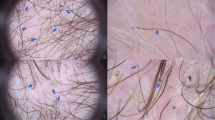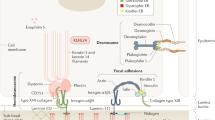Abstract
Toxic epidermal necrolysis (TEN) is an epidermolytic skin disorder associated with drug administration. It is associated with an erythematous rash with full thickness epidermal loss and characteristic histology. A 35-year-old woman underwent allogeneic hematopoietic stem cell transplantation (HSCT) for severe aplastic anemia (SAA). She developed an acute epidermolytic rash and TEN was diagnosed on the basis of skin biopsy. In the HSCT setting, TEN should be thought of as an important differential diagnosis of epidermolytic dermopathies. The most distinctive diagnostic test in the differential diagnosis of these disorders is skin biopsy
This is a preview of subscription content, access via your institution
Access options
Subscribe to this journal
Receive 12 print issues and online access
$259.00 per year
only $21.58 per issue
Buy this article
- Purchase on Springer Link
- Instant access to full article PDF
Prices may be subject to local taxes which are calculated during checkout

Similar content being viewed by others
References
Mockenhaupt M, Schoepf E . Epidemiology of drug-induced severe skin reactions Sem Cutan Med Surg 1996 15: 236 243
Wintroub BU, Stern R . Cutaneous drug reactions: pathogenesis and clinical classification J Am Acad Dermatol 1985 13: 167 179
Revuz JE, Roujeau JC . Advances in toxic epidermal necrolysis Sem Cutan Med Surg 1996 15: 258 266
Schwartz RA . Toxic epidermal necrolysis Cutis 1997 59: 123 128
Sluysmans T, De Bont B, Cornu G . Acute epidermal necrolysis or Lyell syndrome Eur J Pediatr 1987 146: 199 200
Ladhani S, Joannou CL, Lochrie DP et al. Clinical, microbial and biochemical aspects of the exfoliative toxins causing staphylococcal scalded skin syndrome Clin Microbiol Rev 1999 12: 224 242
Avakian R, Flowers FP, Araujo OE et al. Toxic epidermal necrolysis: a review J Am Acad Dermatol 1991 25: 69 79
Roujeau JC, Chosidow O, Saiag P et al. Toxic epidermal necrolysis (Lyell syndrome) J Am Acad Dermatol 1990 23: 1039 1058
Roujeau JC . Treatment of severe drug eruptions J Dermatol 1999 26: 718 722
Friedman HZ, Arias AM, Catchatourian R et al. Toxic epidermal necrolysis following bone marrow transplantation Cutis 1984 43: 158 162
Villada G, Roujeau JC, Cordonnier C et al. Toxic epidermal necrolysis after bone marrow transplantation: study of nine cases J Am Acad Dermatol 1990 23: 870 875
Revuz J, Penso D, Roujeau JC et al. Toxic epidermal necrolysis. Clinical findings and prognosis factors in 87 patients Arch Dermatol 1987 123: 1160 1165
Craven NM . Management of toxic epidermal necrolysis Hosp Med 2000 61: 778 781
Author information
Authors and Affiliations
Rights and permissions
About this article
Cite this article
Zakrzewski, J., Lentini, G., Such, U. et al. Toxic epidermal necrolysis: differential diagnosis of an epidermolytic dermopathy in a hematopoietic stem cell transplant recipient. Bone Marrow Transplant 30, 331–333 (2002). https://doi.org/10.1038/sj.bmt.1703624
Received:
Accepted:
Published:
Issue Date:
DOI: https://doi.org/10.1038/sj.bmt.1703624
Keywords
This article is cited by
-
Dermatologic Conditions of the Early Post-Transplant Period in Hematopoietic Stem Cell Transplant Recipients
American Journal of Clinical Dermatology (2019)
-
Toxic epidermal necrolysis and Stevens-Johnson syndrome
Orphanet Journal of Rare Diseases (2010)



